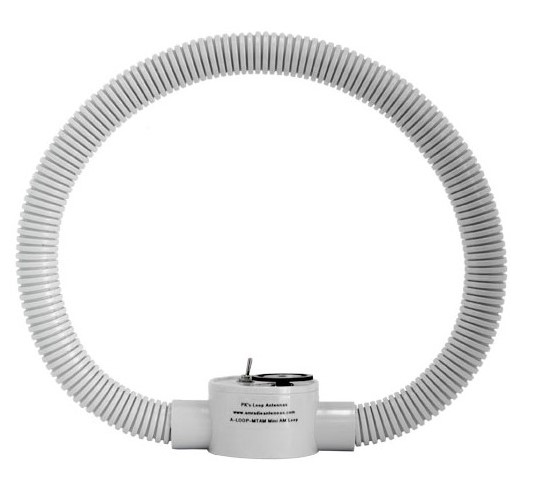Many thanks to SWLing Post contributor, Ron, who shares the following review of the PK Loop Mini (A-LOOP-MTAM):
Standard PK Loose-Coupled Loops (the “A” series) are 14 inches in diameter…they are
for use with a receiver having a built-in ferrite bar antenna.Don’t think they’re not capable of serious DX…a few years ago a friend in Texas
snagged and recorded France Inter (162 kHz) on a 14 inch standard PK LW
loop using a Sony 7600GR.But this is about the PK Mini 10 inch loop for Medium Wave (there are none for
other ranges).The build quality is superb as with all PK loops. The band has two ranges: 525 to
710 and 710 to about 1720 kHz. Paul Karlstrand uses a unique design consisting
of flat computer cable and a custom made circuit board to connect the turns
end-to-end.The low end simply switches in a fixed capacitor across the variable to lower the
frequency.The Mini has 25% less sensitivity than the standard 14 inch loop according to the website.
Currently it can be had for $66 USD delivered to your door from Melbourne…this one
was ordered on a Monday and showed up a week later,which is outstanding considering
it had to clear customs in NYC.Performance is virtually identical with the Tecsun or Terk loops, which are 9 inch loops.
So why buy a PK?You get what you pay for, or not…the PK is fairly robust compared to the Tecsun or Terk.
It’s made to last and it’s a PK Loop.Here are some links for comparison purposes:
If you wish to enhance your loop try co-coupling it to your receiver with a Q-Stick :
Thank you, Ron, for sharing your experience with the PK Loop Mini. It certainly sounds like an excellent option for travelers and, like you, I agree that the construction quality is superb!


How does this compare to the C.Crane Twin Ferrite loop?
https://www.ccrane.com/item/ant_am_twin/101105/twin_coil_ferritereg;_am_antenna_signal_booster
Don’t know but keep in mind the C.Crane is an “active”,or amplified antenna while the
loop is a “passive” or unamplified one.
Amplified antennas generally do better but one can’t make a direct comparison,it’s
apples and oranges.
Had an amplified PK loop once and sold it,it completely overloaded (or swamped) the
portable receiver and was completely useless.
It was your receiver that was the problem. Not the loop.
RonF said it right, there is nothing to reinvent here. A simple loop antenna made with flat cable like the ones that enthusiasts have been making for decades with a few dollars.
Too small for serious dxing it targets to a new generation of radio listeners that are not interested to make simple things and often are not even interested to know how things work.
I really don’t want to sound like a cranky & miserable old man, but:
> “… a unique design consisting of flat computer cable and a custom made circuit board to connect the turns end-to-end.”
I smile when I read things like that. It might be “unique” in commercially-available loops, but the basic idea was a pretty common home-brew technique back in the 70’s, when ribbon cable started becoming easily available. In fact I’m pretty sure it’s even older than that; I could swear I saw the same technique done with bundled multi-conductor cable in one of the pulp electronics magazines back when I was a kid.
And I’m not sure a circuit board that connects the ends together in an offset fashion really deserves the accolade “custom-made” – especially when newbies across the hobbies are churning out much more complicated boards as their first design every minute…
But those things aside, the PK loops I’ve tried have been good performers. I’m just not convinced they perform any better than most other small multi-turn loops you could buy or home-brew. That’s not to take away from Paul – they appear to be sensible, good-performing designs and, at least in Australian terms, are fairly priced (I say, as I squint darkly at just about every other loop antenna manufacturer in the world… ?). But each to their own, I guess…
Hello RonF and Max:
I agree with both of you 100%…Thomas asked for a review and “it targets to a new generation of radio listeners that are not interested to make simple things and often are not even interested to know how things work” as Max said.
I’m one of you,a ham since ’62,built a ton of stuff (and have the appendix scar to prove it)
and sure,my homebrew hula hoop longwave loops outperform these smaller ones.
But you have to start somewhere (like we did) and hopefully some young’un will begin with
this.
73,ron